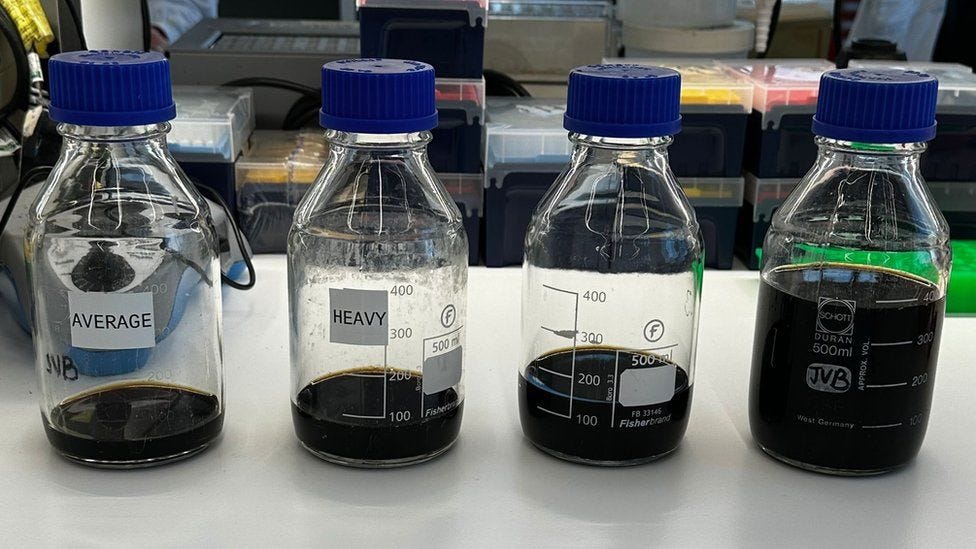Can we discuss the bloody problem?
Let's talk menstruation & periods research and why we really need more of it ASAP.
The first study to use blood to test the absorbency of period products was published in August 2023.
If that doesn’t seem wild to you, please take a quick moment to realise that 26% (~1.8 billion) of the world’s population menstruates every single month for 5-7 days. It affects a significant chunk of the population.
Now, some of the people closest to me are scientists, so I like to fact-check words like “the first-ever” before dissecting why it’s so ridiculous that this hadn’t already happened.
Why is testing with (period) blood so important?
Upon further reading & research, the study doesn’t claim to be the only one using blood to test period products. Still, it is probably the first one to do so with modern-day products like pads, tampons, cups, discs, and underwear.
The companies creating these period products have been testing their absorbency with saline (salt water) — which is nowhere close to the consistency of period blood. In fact, even this August study doesn’t use period blood. It used expired donated blood, which, while thicker than saline & fresh blood, isn’t the same as period blood.
Most of the period product ads I’ve seen on TV during my childhood & teenage years have featured blue water — never the red of blood, and now I’ve realised it was just blue saltwater. No wonder almost every menstruating person has bled through these products at least a few times.
A critical reason to test absorbency with blood (period or as close as possible) is to offer more clarity on blood loss. Some folks experience heavy bleeding during their periods. With the wrong understanding of how much their period product can absorb, they may not realise they’re at risk for issues like anaemia and other health problems.
“If we know the correct method to measure blood loss, only then can we educate others and catch and treat heavy menstrual bleeding. To do so, we need more research on this topic.”
Why is there such little research on menstruation?
In general, studies researching things that affect menstruating folks (chiefly women) are less common than you’d expect.
A 2020 review found 400 papers in 2011-2018 mentioning “menstrual blood” in the PubMed database, while more than 10,000 mentioned semen.
And this lack of knowledge bleeds (pun intended) into real life, too. So many of my friends have visited doctors & gynaecologists for severe cramps, heavy bleeding, and a myriad of issues.
The standard response has been, “Oh, that’s common, you just have to take a painkiller and bear it.”
Sometimes, they deign to diagnose you with endometriosis or PCOS, and offer some friendly advice to lose weight, exercise more, or even more delightfully — get married and have a baby.
1 in 10 menstruating people (~11%) have endometriosis, and it brings along debilitating pain and infertility (among a whole host of problems). It was discovered 160 years ago, but we still haven’t gone beyond basic management cures. FYI, endometriosis literally tangles a person’s organs; different (parts of) organs stick to each other to cause pain that can be paralysing for days.
This gap in research around menstruation probably has several reasons. Stigma, for one. Talking about periods is still considered vulgar & distasteful1. This means that people often aren’t aware of how normal it is to menstruate and how important it is to have information even if you don’t menstruate.
Gender bias is also a reason we know so little about periods and how they affect our bodies:
For decades, male investigators published scientific articles based only on male subjects, whether they were animals or humans. A male investigator would ask a scientific question of interest to him and answer it with male data. When researchers were asked to justify those decisions in the 1940s and 1950s, they blamed it on—you guessed it— women’s hormones, claiming that females were more difficult to study because of menses and therefore should be left out of the research equation entirely.
As the world deals with (or conveniently ignores) the aftermath of the Covid-19 pandemic, its impact on menstruation still needs to be researched. However, pretty much anyone I know who had a rough bout of covid in 2020 & 2021 has experienced severe changes to their periods. Cramps are worse, cycles delayed — a potential side-effect of long-covid.
Menstruation and the week before menstruation have been identified by patients as triggers for relapses of long COVID symptoms. Individuals with both COVID-19 and menstrual changes were more likely to experience fatigue, headache, body ache and pain, and shortness of breath than those who did not have menstrual changes, and the most common menstrual changes were irregular menstruation, increased premenstrual symptoms and infrequent menstruation.
Why do we need to discuss periods (and how it affects us) more openly?
A recent topic of discussion among my friends has been how awful our periods have gotten since we turned 25. People went from having no cramps or pain to having to take days off on their periods, dealing with extreme depressive episodes or sadness, and extreme changes in their bodies. None of this was ever mentioned or discussed by any older person around us. No one prepared us for these changes — a little heads up in our school textbooks, the news, or even a TikTok would’ve been great.
Nearly 10% of people who menstruate have period pain so severe that they cannot complete their daily activities for one to three days.
For years, we’ve believed that people only lose a few tablespoons of blood during their periods. And while that’s technically true, it’s more than it seems.
Here’s an actual visual representation — a real one — of how much blood women lose every month through a lot of pain and discomfort.

This is why the study being conducted with real blood is so important. And that’s why so many people are mad it’s taken so long for it to happen. Menstruating folks have been dealing with limited information, gaps in understanding of what’s happening to their bodies, and sometimes even misinformation.
The more we research and fund accurate studies on menstruation & periods and how they affect people across the world, the easier it is to develop life-saving treatments. It shouldn’t only become something worth studying when it affects fertility.
The real question is whether there’s the will from research scientists, from funding bodies, from healthcare professionals and from those in government with the power to change priorities, to take what’s happening here and turn it into effective treatments that will make a difference to the lives of so many people. — BBC
What did you think of this issue?
Your anonymous feedback helps me improve. Thanks!
If you liked this issue (or like the newsletter in general), feel free to buy me a coffee or two!
Life update: In case you missed me in your inbox last week, I was off attending my best friend’s wedding! Here’s what their mandap looked like!
Fun links of the week! 🚀
Find out how long it takes to read any book.
Brighter, warmer days ahead:
Thanks for reading! Please tap the heart if you liked this issue (or like the newsletter in general) so the algorithm overlords take pity on me lol.








“It shouldn’t only become something worth studying when it affects fertility.” LOUDER FOR THE PEOPLE IN THE BACK!! 📣📣📣
Brava! The lack of studies is woeful and means GPs who are struggling with a chasm of knowledge on many female issues. Unfortunately the changes keep kicking us in the ovaries - when I hit 30 they ramped up another level. I struggled to conceive for 4 years and only when operated on did they find fibroids and endo - with a huge section of my bowel attached to my uterus. 40 brought about more issues and thankfully through talking a lot more with friends and colleagues, I'm a little more prepared for what might be in store. However, the anecdotal doesn't translate into medical action so many menstruating people will be struggling on blinkered by the absence of tests, research and 'real' intelligence on the topic.